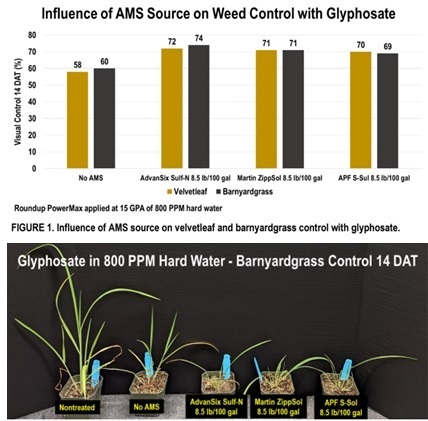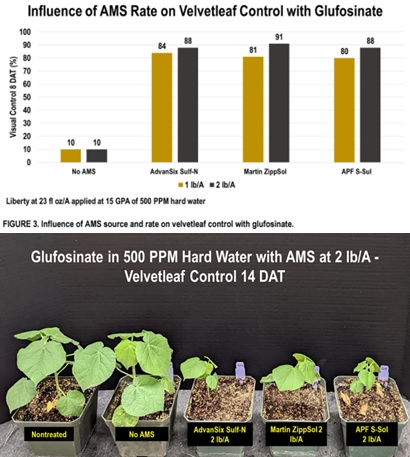AMS Color Doesn’t Affect Weed Control Performance
Many farmers use ammonium sulfate (AMS) as an adjuvant in conjunction with glyphosate and glufosinate to reduce hard water antagonism and improve herbicide efficacy. Just like fertilizer AMS, adjuvant AMS products can vary in color from white to light brown, depending on the manufacturing process. Companies selling these products often mislead users by attempting to associate lighter color product with higher purity and greater effectiveness. Researchers at Purdue University recently conducted a study on three common AMS adjuvants to compare the performance of white AMS products (Martin Midstrean Partner’s ZippSolTM AMS adjuvant and American Plant Food’s S-SulTM AMS adjuvant) with a brown colored product (AdvanSix’s AMS adjuvant) and found that the brown colored product performed just as well as the white products.
Experiment Design
Researchers visually evaluated the control of barnyardgrass and velvetleaf that were treated with either glyphosate or glufosinate in conjunction with each of the three AMS adjuvant products. Researchers evaluated the AMS/herbicide mixtures at three different water hardness levels: zero, 500, and 800 parts per million. The herbicides used in the experiment were Bayer’s Roundup PowerMax herbicide (16 fl oz/ac for barnyardgrass and 23 fl oz/ac for velvetleaf) and BASF’s Liberty® herbicide (23 fl oz/ac for velvet leaf). For the glyphosate study, each of the three AMS products were mixed at a rate of 8.5 lbs/100 gal and tested against both the untreated weed and the weed applied with glyphosate only (no AMS adjuvant used). For the glufosinate study, each of the three AMS adjuvants were mixed at rates of 1lb/ac and 2lb/ac and compared to the untreated weed and the weed treated with glufosinate only (no AMS adjuvant used). Researchers evaluated weed control on the 14th day after treatment.
Results
This study concluded that there were no significant differences in herbicidal treatment for barnyardgrass and velvetleaf control between the colors of AMS adjuvants; all three AMS adjuvant/glyphosate mixtures performed better in barnyardgrass and velvetleaf control than glyphosate alone.

(“Does AMS Color Influence Weed Control with Glyphosate and Glufosinate”, Johnson, Young and Zimmer, 2022)
This study identified a significant increase in herbicide efficacy with the addition of an AMS adjuvant in conjunction with glufosinate for controlling Velvetleaf, regardless of the color of the AMS adjuvants used. Glufosinate alone controlled the velvetleaf growth by around 10%, and glufosinate in conjunction with AMS adjuvants controlled the velvetleaf growth by at least 80%. As with the glyphosate results, there were no significant differences in controlling velvetleaf growth between any of the three colors of AMS adjuvants.

(“Does AMS Color Influence Weed Control with Glyphosate and Glufosinate”, Johnson, Young and Zimmer, 2022)
Conclusion
The three AMS adjuvants performed similarly when mixed with glyphosate and glufosinate to reduce hard water antagonism. The Purdue Extension bulletin notes “the results of this greenhouse experiment indicated that there are really no differences in the control of barnyardgrass and velvetleaf with glyphosate, or velvetleaf control with glufosinate with these three sources of AMS. The off color AMS product worked just as well as the white color AMS product in these trials.” While manufacturers and retailers may try to sell AMS adjuvant based on color, this study shows that the brown AMS adjuvants perform just as well as the white colored products.
To see the full write-up from Purdue University Extension, click here.